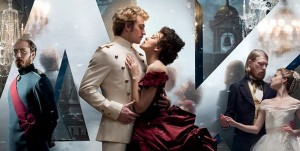Anna Karenina
Posted on November 15, 2012 at 6:00 pm
Director Joe Wright and his favorite star, Kiera Knightley (“Pride and Prejudice,” “Atonement”) have produced a ravishing, highly theatrical version of Leo Tolstoy’s classic “Anna Karenina.” It is deeply romantic but has more focus on the social and political context than many of the previous versions of the story. It literally opens with the rise of a curtain over a grand proscenium stage, and throughout the film the story flickers from movie-style reality — not documentary but an integrated dramatic narrative — to something resembling a live production of a play or ballet. At one intensely dramatic moment, the story literally and metaphorically spills over the edge of the stage for a shocking denouement.
Anna (Knightley) is a young mother married to the stiff but not unfeeling husband Karanin (Jude Law). He cares for her but is very caught up in legislative and governance issues. When we first see her, Anna is preparing to leave her home in St. Petersburg to go to the aid of her brother, Stiva (Knightley’s “Pride and Prejudice” co-star Matthew MacFadyen) and his pregnant wife, Dolly (“Boardwalk Empire’s” Kelly Macdonald), who is devastated when she learns he has been having an affair with the governess. Anna hopes she can help the couple reconcile. And she is not unhappy about spending time in Moscow, going to parties and concerts and mingling with members of society.
There she meets the dashing officer Count Vronsky (Aaron Taylor-Johnson of “Kick-Ass” and “Savages”). Vronsky is a bit spoiled by a life in which everything has come easily to him — good looks, money, women. He is flirting with Dolly’s sister, an innocent young princess named Kitty (an excellent Alicia Vikander). Stiva’s close friend Levin (Domhnall Gleeson), a shy but true-hearted landowner, loves Kitty. He proposes, but, believing Vronsky will ask her to marry him, Kitty turns down Levin’s proposal. Vronsky has just been flirting with Kitty. He is drawn to Anna. She is drawn to him, and returns home to put some distance between them. He pursues her, and finally, she is overcome. Besotted by him, she is overcome in every way, breaking every rule, ignoring every convention, the freedom as heady as the romance.
Like too many lovers before her, she believes that love is enough, that the world will support her, that nothing else matters. She once counseled Dolly to rise above Stiva’s infidelity. But she does not have any sympathy for Karanin’s humiliation or any gratitude for his willingness to stand by her, even when she is pregnant with Vronsky’s child. Vronsky genuinely cares for her and does his best but he is out of his league. When Anna realizes that society has no place for her anymore, she is devastated. Tolstoy’s focus on the reunited Levin and Kitty, far from the glittering parties and gossip, contrasts the hypocrisy, artificiality, and sterility of the upper class with the authenticity and humanity of the people who work the earth and care for the sick.
Wright has a magnificent gift for images and a remarkable fluidity of camera movement (remember that bravura sustained shot on the beach in “Atonement”), all used in service of the story and characters. The camera circles as the story does, with rings of parallel but contrasting stories. Watch Anna’s costumes, elaborate, constricting at first and then simpler. In the midst of her passion for Vronsky, they both wear white, as though they are removed from the rest of the world. Later, she’s swathed in black. Watch for images of omens, and images that compare or contrast the human world and the animal world, the fake and the real. By embracing the artificiality of the form, Wright illuminates not just Anna’s anguish but Tolstoy’s vision.
Parents should know that this film includes sexual references and situations with some explicit images and suicide and a brief shot of a mutilated body. Characters drink and abuse alcohol and drugs and there are tense and unhappy confrontations.
Recommendation: Mature teens-Adults
Family discussion: Tolstoy famously begins this book by saying that all happy families are alike but each unhappy family is different in its own way. Do you agree? How does the theatricality of the setting affect the story?
If you like this, try: the other versions of the story, especially the movies with Greta Garbo and Jacqueline Bisset, and the book by Tolstoy


One Reply to “Anna Karenina”
Comments are closed.